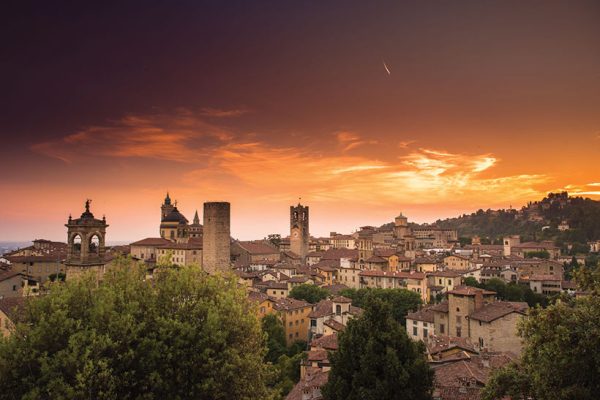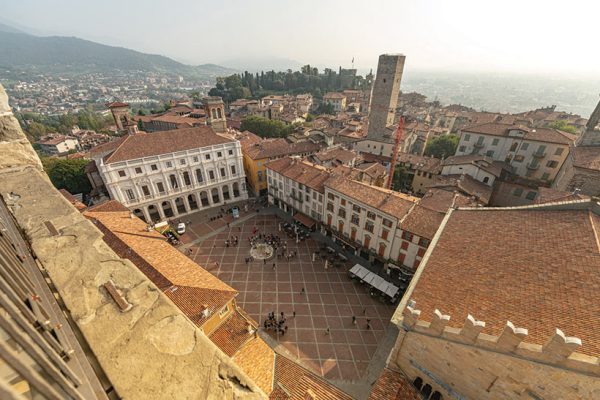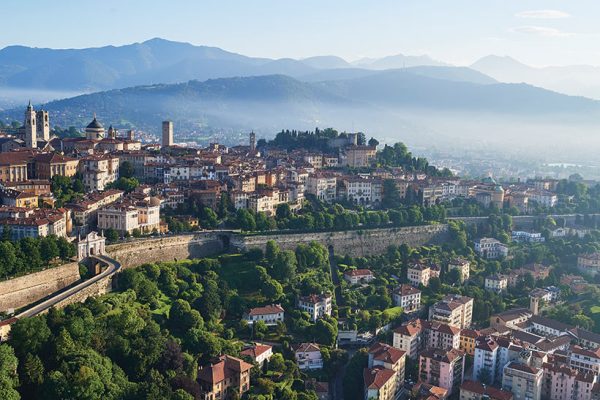Rachael Martin visits Bergamo, one of Italy’s two Capitals of Culture for 2023, a gem of a city in the heart of Lombardy

Even as you approach Bergamo and first see it from a distance, you can already sense that you’re in for something special.
The name Bergamo – or Bèrghem as the locals call it in their dialect – comes from the name of the Celtic mountain god Bergimus, and your first impression is that of its upper part, a fine Italian hilltop walled town set against the mountains and looking out over the Po Valley.
And when you do finally enter the city you quickly see that Bergamo also has a wealth of cultural and artistic treasures to offer – its Piazza Vecchia is said to be one of the most beautiful squares in Europe – as well as beautiful green spaces, such as the Orto Botanico “Lorenzo Rota”, open daily during the warmer months.
This is one of the great cities of Lombardy – the city of the composer Gaetano Donizetti, and that of a much-loved pope, John XXIII (1958- 1963), who came from the village of Sotto il Monte in Bergamo province.
And it is the city that, along with its neighbour Brescia, was hit most heavily by the Covid pandemic. And so 2023’s celebration of both cities as Italy’s Capitals of Culture is most welcome to their famously hardworking and community-minded people. If you have never been, there is no better time than now.

Old and new
Bergamo is a graceful mix of old and new, and is clearly divided into two distinct parts. There’s the Città Alta, the Upper City, with its medieval towers and views over the Po Valley, and the Città Bassa, the Lower City, with its grand tree-lined avenues and bustling streets.
If you’re spending 48 hours here, it’s easy enough to plan your itinerary : spend one day in Città Alta and the other in Città Bassa. Città Alta, the Upper City, is the older part and this is where we will begin our voyage of discovery.
Città Alta
High up on its hill and looking down over everything, Città Alta has always prospered thanks to its strategic position, and this is one of the few Italian cities where the old part is enclosed by the original city walls.
These UNESCO-protected walls were built with Venetian money after the Duchy of Milan was defeated in the 16th century and Bergamo became part of the Venetian Republic.
There are four gates by which you can enter the Upper City. If you fancy the walk, you can go up from Città Bassa and enter through the Porta San Giacomo.
If you don’t, Bergamo is famous for its funiculars, of which there are two: one that links Città Bassa with Città Alta and one that links Città Alta with the Colle di San Vigilio.
Take the funicular from Città Bassa to Città Alta, and you’ll reach Piazza Mercato delle Scarpe, one of the most important squares in the city, where merchants from Venice and Milan once met.
The thing that strikes you about Città Alta is its beauty. This walled town is an utter pleasure to explore.

Stand in Città Alta’s Piazza Vecchia, which French architect Le Corbusier called “the perfect square”, and you are standing in what is traditionally the heart of the city’s political power.
At one end there is the Palazzo della Ragione; at the other, Palazzo Nuovo. Palazzo della Ragione, also known as Palazzo Vecchio, was built in the 12th century and divides Piazza Vecchia from Piazza Duomo.
It takes its name from the days when it was used as a court (ragione means ‘reason’, in the sense of ‘justice’ or ‘rightness’. Look for the Lion of St. Mark, symbol of the Venetian Republic, on the Palazzo and on the 18th-century sundial in front of it, which still marks midday and the date.
Palazzo Nuovo is now a library, the Biblioteca Angelo Mai, and home to early manuscripts, books and prints. Palazzo del Podestà was once home to the city’s Venetian Republic governor and is now a museum dedicated to 16th-century Bergamo. The city’s civic tower is also here.
Walk into Piazza Duomo and you are now in the city’s spiritual centre. To your left, there is the city’s cathedral, the Cattedrale di Sant’Alessandro Martire, seat of the city’s bishop.
Look for the statue of the city’s pope, John XXIII, or Papa Giovanni as he is known here. Moving along , there is the Basilica di Santa Maria Maggiore.
If the cathedral is the place for official religious celebrations, the Basilica is the church of the people.
Next to it is the Cappella Colleoni, another fine example of Renaissance architecture, and next to that the Baptistery, built in the 14th century by the sculptor Giovanni da Campione.
These are the Città Alta’s two most important squares, and you could easily spend a day exploring the surrounding streets, walking along the city walls, and taking the funicular up to the Colle di San Viglio.
It’s a place to definitely be savoured at leisure, with coffee or lunch, to really allow you to soak up the atmosphere. And don’t forget a visit to Gelateria La Marianna, where stracciatella ice cream was invented!

Città Bassa
Città Bassa, with its elegant tree-lined avenues, is the perfect contrast to the medieval Città Alta. It’s a modern, lively city that was built upon the sites of villages – borghi – such as Borgo Pignolo, Borgo Sant’Alessandro and Borgo Palazzo, all of which grew up along the roads leading up to Città Alta.
The Centro Piacentiniano is known as the city’s salotto, or drawing room. It was designed by the architect Marcello Piacentini at the beginning of the 20th century to give the Città Bassa a new, modern centre.
Here you’ll find the Teatro Donizetti, the Torre dei Caduti and the Church of San Bartolomeo with its Lorenzo Lotto altarpiece Madonna and Child Enthroned with Saints.
Together with the site of the Centro Piacentiniano, the road known as Il Sentierone (literally, the large footpath) has been the city’s heart for over four hundred years. It’s one of the city’s busiest streets, and also great for shopping.
Shopping is serious business in Bergamo. The Bergamaschi, as the people of Bergamo are called, like to be well-dressed, and to sit outside any café in the centre of Bergamo is like being at a fashion show. For nightlife, head to Piazza Pontida, once a meeting point for artists and 19th-century revolutionaries and now a lively centre for shopping and bars.
Also walk along Viale Papa Giovanni XXIII, which leads to the city’s elegant Porta Nuova, built in 1837 to commemorate the visit of Ferdinand I of Austria. It’s here where you can get some of the best views of the city above, and the perfect picture to take home from this beautiful city.
For the latest travel blogs, subscribe to Italia! magazine
All photos © Visit Bergamo
